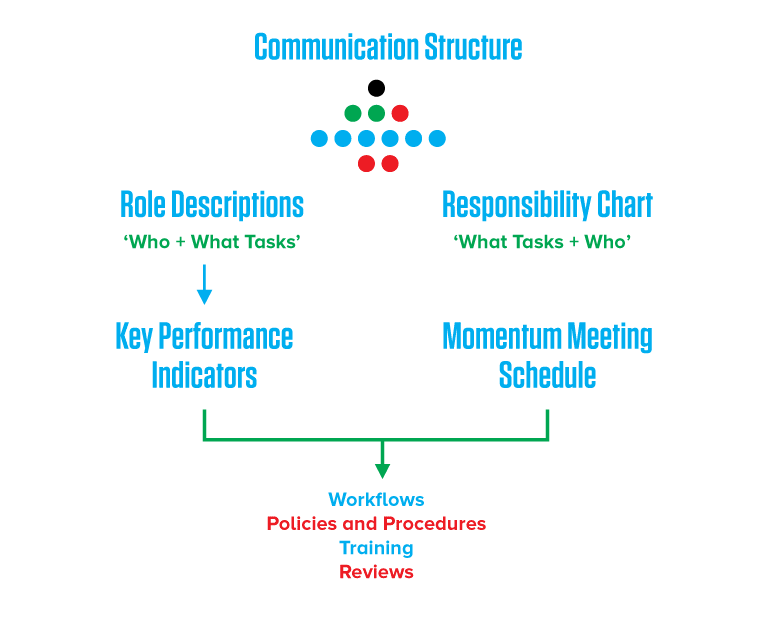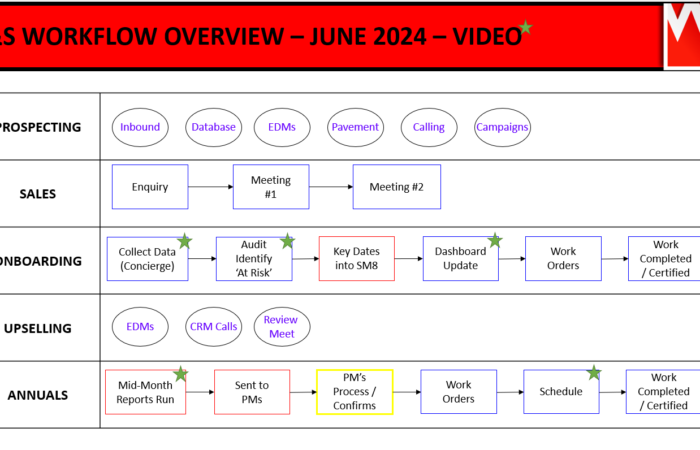Would you like to Create 20% Extra Profit? In Blackboard Fridays Episode 56, Jacob talks about Operational Structure, Productivity, Learning and Development, and Systems and Processes. Need this implemented into your business? Talk to the international business advisor who can do exactly that – Contact Jacob, Learn More, or Subscribe for Updates.
As we continue to climb out of the global financial crisis [2024 Edit: those Cycles are real, and now we’re climbing out of the Coronavirus Recession] , increasingly I’m talking to business owners who are ‘busy’. Here’s the critical follow-up question I ask: “Are you busy busy, or good busy?”
Because we all know that there’s a gaping void between being ‘busy’ … and being ‘productive’. If you could improve productivity in your team, reduce waste and improve their efficiency, the extra revenue they produce would flow almost wholly to your bottom line – it’s revenue without costs!
In this week’s episode, learn more about how our R’n’R framework is delivered across a whole business to improve productivity and increase profit. We cover:
- Having the right communication structure
- Colour-coding your position descriptions
- Charting responsibility, so you’re not doing the same task twice
- Drafting Ideal Weeks for key roles
- Implementing the Momentum Meeting Schedule
- And then implementing through Workflows, Procedures, Training, and Reviews
Want more profit? Make this happen (or let us know – we can help).
Who is Jacob Aldridge, Business Coach?
“The smart and quirky advisor who gets sh!t done in business.” I work with business owners who want more flow and flexibility.
Since April 2006, I’ve been an international business advisor providing bespoke solutions for privately-owned businesses with 12-96 employees.
At this stage you have proven your business model, but you’re struggling to turn aspirations into day-to-day reality. You are still responsible for all 28 areas of your business, but you don’t have the time or budget to hire 28 different experts.
You need 1 person you can trust who can show you how everything in your business is connected, and which areas to prioritise first.
That’s me.
Learn more here. Or Let’s chat.
Transcript
In this episode of Blackboard Fridays, we’re going to talk about how you can create at least 20% extra profit in your business.
And the first critical question to understand – without judgement – is this: How have you created a business where 20% extra profit is getting lost and is getting missed?
The reality is, if you’re like 80%-90% of business owners out there, your business has grown organically. You’ve gotten busy, you’ve hired the next person, they’ve gotten busy, they’ve encouraged you to hire the next person and so on. Multiply that out by many years of business and many team members, conversations, decision, documents, half thoughts… Sound familiar?
All of these things create dysfunction within an organization. They’re also incredibly common and perfectly normal, neither fact of which means you don’t want them changed.
The R ‘n’ R Process
What we do through the R ‘n’ R process is:
- unpick all of that dysfunction,
- look at the contextual decisions you’ve made in the past,
- make the changes there, at context, and
- recreate the systems and structures in a way that’s as efficient as possible when no profit and no time gets lost.
Here are the different elements. Refer above for deeper specific videos on every element.

Let’s link back to Episode 50, the Contextual business plan that “makes sh!t happen in business”. All of the different elements of this RNR System sit at that Systems layer of context.
Make key decisions here that are relevant for the size and the stage of your business, and you will find that your business is a whole lot easier.
1. Communication Structure
It starts up the top with your Communication Structure. I’m not an Org Chart (Organisation Chart) kind of fan, because I don’t feel that in modern business having a hierarchy is going to help you.
However, you do need to be clear about who communicates what to whom. What are the key processes and channels for that communication so that it happens as efficiently as possible?
You need to link this to your capacity engine and your strategic roadmap. What’s the right number of resources for the business to be as optimally profitable as it can be?
You can also see that every person is included in a Communication Structure. Some Org Charts do that, some don’t. There are charts where you only want to demonstrate your various roles (some of which will have multiple occupants) or key responsibilities (not everyone in a business has a high level functional responsibility).
But we want to see both how many people are on your team, including full-time contractors, and we also want to colour their roles according to the RNR Colour System.

If you tell me your industry (so I can estimate average gross profit margins) and then simply show me a completed Communication Structure chart, I can tell you pretty quickly whether there’s 20% waste that we can convert to profit … or whether there’s a whole lot more.
2. Roles and Responsibilities
If you haven’t watched any other RNR Videos, you’ve probably guessed that RNR stands for “Roles n Responsibilities”. And you’d be half right – it also stands for “Rest n Recuperation”, which is what roles and responsibilities give a business owner (especially those who choose 1 extra day per week of freedom, instead of needed 20% more profit).
So our Communication Structure shows us who our resources are and what their roles roughly entail. Next we move down to step 2, which is getting clear on the roles and responsibilities. And we’re separating those two topics out.
On the one hand, we have Role Descriptions. On the other hand, we have a Responsibility Chart. This is the same information presented two ways for maximum impact.
A position description (I don’t really care whether you call it a Role Description, Position Description, Job Description, or Position Profile. You can even abbreviate it to RD, PD, or JD … but probs not PP) is simple. It’s a list of:
- What the role is
- Who is filling that role, and
- What tasks is that role responsible for.
(Noting that the template I provide clients also includes the context of the role, key reporting lines, timeframe focus, and cultural expectations.)
The Responsibility Chart is the flip. It takes the tasks and lists out who is responsible.
In the video I use an example of my partners at businessDEPOT, which had 50 team members at the time I was the Accounting Firm Partner there. If I had a question about my computer and wanted to know who to ask, who was responsible for IT … am I expected to read through 50 different position descriptions to find out who has IT on their position description?
Of course not. Going Role>>Responsibility doesn’t help that use case. I need to go Responsibility>>Role – so I can look at the Responsibility Chart, find IT (which sits in Red Admin) and know that I need to go and have a conversation with that person.
Linking these two – PDs and the Chart – reduces an awful lot of waste and ensures that the right person is always doing the right job at the right time.
If the thought of documenting job descriptions haunts you … be sure to watch this video / read this article where I outline the easiest way I’ve ever found to do this project and do it effectively.
3. Ideal Weeks and Key Performance Indicators
Now, we need to flow down from those two elements.
For the roles, I like to talk about source and outcome.
At a source level – where can an individual in that role focus now to create results later – has each individual got an idea of their ideal week or perhaps their ideal month?
Of all the tasks that they are responsible for, do they know when is the optimal time for them to be doing it? That’s not going to apply to every business and every role, but it’s a platform for them to perform and a simple accountability tool you or your managers can use when an individual goes off piste.
And how do you know when the skis are heading in the wrong direction? What are the outcomes you can track for that source focus?
Key Performance Indicators (again, there are trends for things like OKRs or Value Metrics – the key is “What are the simple to gather, objective to examine measurements that let’s someone know they’re performing in their role, and let’s me manage them without micromanaging).
4. The Momentum Meeting Schedule
In episode 37, we went into detail around the Momentum Meeting Schedule. How to get those groups of individuals and those responsibilities meeting on a regular basis so that they’re communicating and making decisions in a way that saves you, the business owner, a whole lot of time stops you from becoming a bottleneck.
Implementing that meeting schedule helps make sure that the responsibilities are undertaken within the business.
5 through 8: Workflow, Policies & Procedures, Training, Reviews
Now we start to flow down from “What” (What roles? What tasks?) into “How” (How does your business operate? Where are there inconsistencies? Speed bumps, hurdles, brick walls, all of the stuff that built in business and how do we get rid of all of that and streamline your operations?)
The next step then is Workflows. We discussed Workflows in great detail here, because if you can create great colorful impactful workflows then stuff will get done faster. Speed is money.
Policies and Procedures scare the heck out of a lot of small business owners … and it should, because if you decide that you, as a four person business, need the policies and procedures of Boeing, then you’re going to go out of business backwards.
Policies and Procedures need to be ‘what’s the level of detail for your business’. Don’t copy the wrong homework.
With he right level of detail agreed, you can now use the Workflows to identify which specific policies or procedures are causing the most pain.
Bite off the elephant one mouthful at a time and actually make that happen rather than trying to jump in and do too much and have it drag down your business. My personal favourite approach is a monthly meeting with the whole Red team, where you sign off on last month’s tasks and then every attendee is assigned 1 policy / procedure to document / review in the coming month.
Once you’ve got clearer Workflows, clearer Policies and Procedures, you need to integrate that into the Training Plan. From building your skills matrix, to running a Training Needs Analysis, to rolling out an annual plan for each of your team members … as long as you keep communicating in advance, your team will remain exited about the learning opportunities that await them.
Lastly, there are little things that matter and there are some that don’t. Understand the difference between those in your business, and that then fits in with your team Reviews.
Sit down with your team, at least a twice yearly process to staff reviews. Once to review their skills and once to review their things like salary, prices, their careers. Separate out those conversations and when you’ve got issues going on at various points in the business, your role as the business owner is to work on the business not in the business.
Look at this as a system. Overview, Helicopter. Context. Don’t get sucked in a little specifics but identify where there are things going wrong in any of those eight steps, rectify them overcome those hurdles, and create at least 20% more profit in your business today.
Next Steps
Want to learn more about how this can apply to your business? It costs nothing to chat:
- Email me jacob@jacobaldridge.com (I read them all)
- Call, Text, or WhatsApp me +61 427 151 181
- Or just Subscribe https://jacobaldridge.com/about/subscribe-to-jacob-aldridge-com/ to stay in touch





[…] are, you need to move that individual on. In episode 56, when I talked about the full R ‘n’ R system, I talked about how 20% of your staff could leave. This is the kind of person who will leave. But […]
[…] Ideal Weeks for your team members is also a practical part of your RNR (Rest and Recuperation) strategy. As a business leader, you can stop wondering whether Tim has checked the mail and Tina has made […]